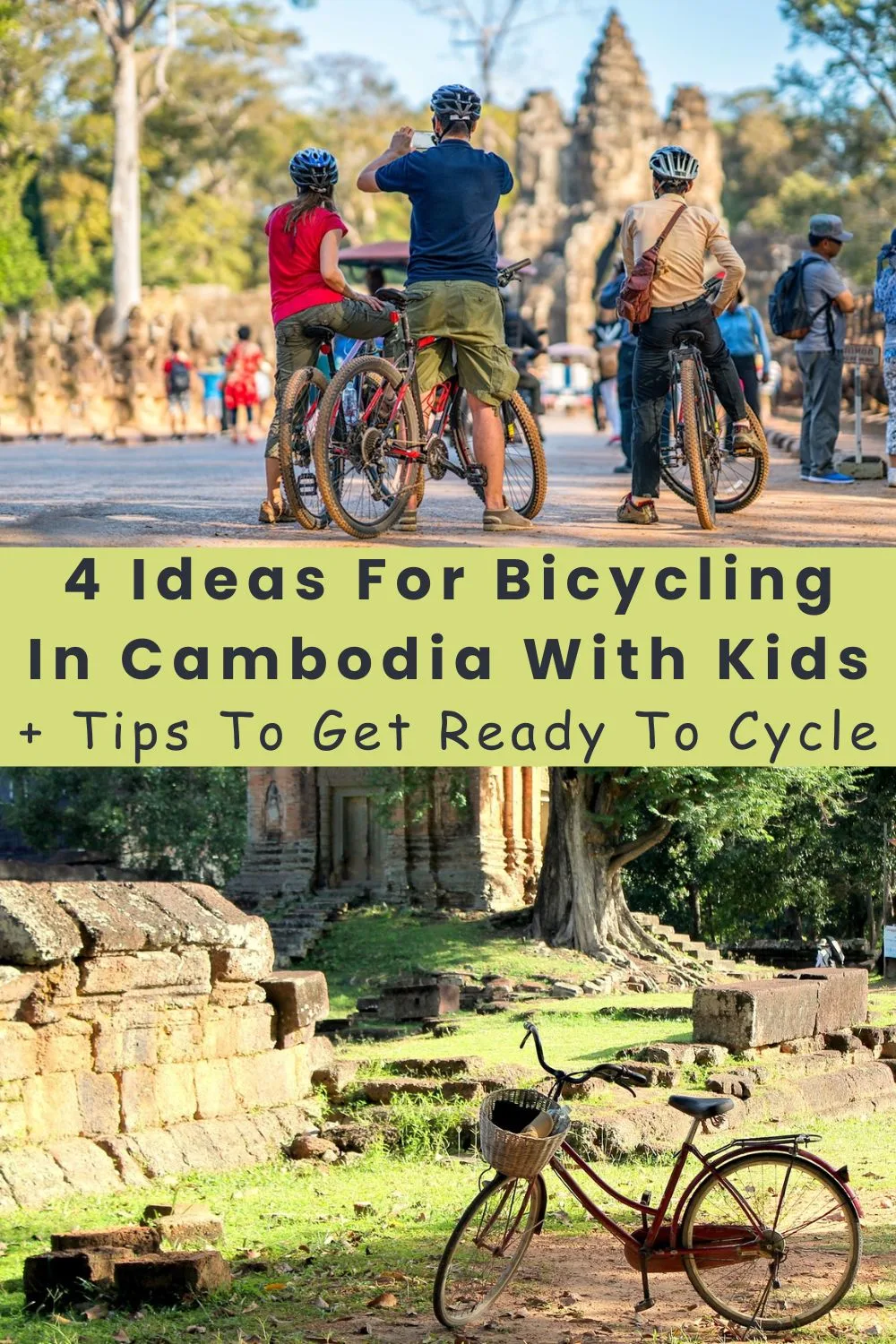Here’s why you might want to explore Cambodia, and particularly the Angkor Wat area, by bicycle, especially with teens, and even with kids:
Cambodia is one of those places where visitors hit the ground running, packing as many temples into as few days as possible before then making short flying visits to Phnom Penh and one or two other places.
But it’s a place where you are amply rewarded if you slow down and take in the details. Cycling for all or just a part of your vacation is the ideal way to do that.
Imagine your family pedaling down a dusty red road, passing emerald rice paddies as a group of giggling kids wave enthusiastically. In the distance, the unmistakable silhouette of an ancient temple fills the horizon.
I’ll help you plan your two-wheeled family adventure. Don’t forget your Cambodia e-Visa to ease your way through immigration and onto those bicycles as easily as possible.
Here’s what to expect on cycling tours of Cambodia’s most popular destinations, along with a few tips to make sure you have a fun and safe journey.
You might also want to read
• Our Guide: Siem Reap & Angkor with Preschoolers
• 10 Things You Love Doing in Hanoi With Kids
• Borneo: The 5 Most Awesome Things To Do With Kids
What To Expect Cycling In Cambodia With Kids
Angkor Wat: Temples and Tomb Raider Vibes
The challenge with Angkor Wat and all the other temple complexes around Siem Reap is that every tourist is going to see the same sights, at around the same times of day. Crowds detract just a bit from the splendor –and your photos.
This is where those cycling tours come in. With two wheels and a guide who knows all the local bike paths, you can safely get off the beaten track and away from the crowds, to the hidden gems tour buses can’t get to.
Some tours start early enough to allow you to catch the sunrise over Angkor Wat. As you pedal through the early morning lights, the only sounds you’re likely to hear are the whir of bicycle chains and the occasional screech of a monkey. It’s possible to feel like you have the whole place to yourself and it’s magical.
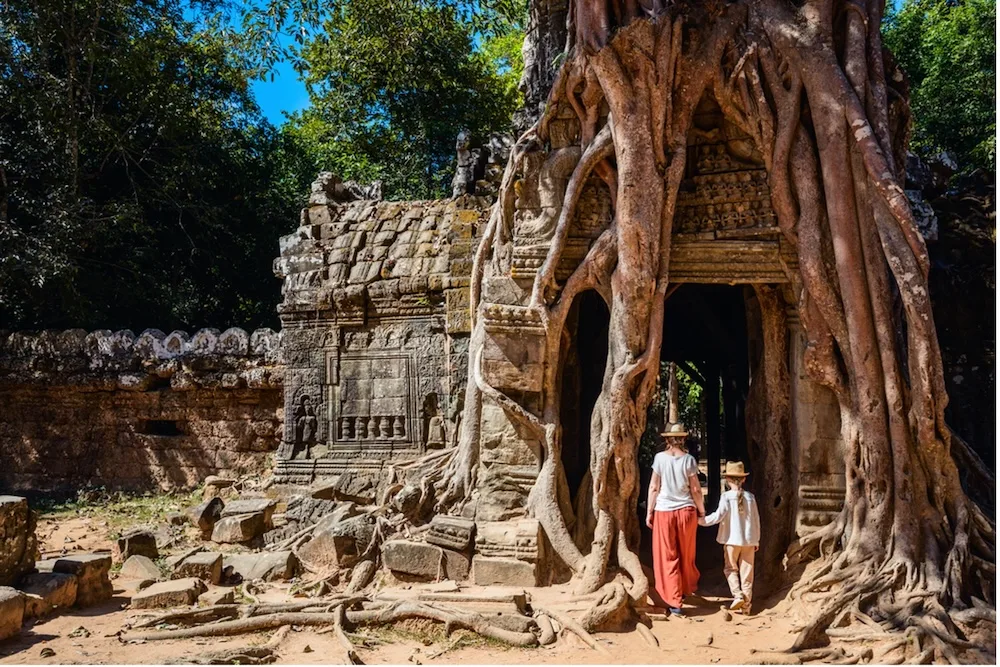
Find a bike tour that will set the right pace for your family. You might ride from Bayon, where its enigmatic carved faces make great photos, to Ta Prohm, where tree roots strangle ancient stonework in a fantastic tangle. Or you might focus on Angkor and other temples close to it.
Rural Rambles: Village Life and Sticky Rice
When your kids get a bit of temple overload and need a break, you can take some time explore Siem Reap’s countryside by bike.
Seat out from the center of town and within minutes, you’ll feel like you’re miles from the tourist crowds.
A typical tour will cycle through villages, where life moves at a slower pace. Watch farmers tending their rice paddies using techniques passed down through generations. Depending on the time of year, you might see men plowing their paddies with water buffalo. It’s as hard as it looks and those buffalo have a wicked sense of humor. So admire their work from a distance.
Absolutely stop at a local market if you happen upon one. The sights, sounds, and smells can offer some sensory overload but push through for one of Asia’s best cultural experiences.
Try some street food if you see it. Meat or fish grilled on sticks and sticky rice in bamboo are a good bet.
You’ll see fruit you rarely if ever see in the U.S., including dragon fruit, mangosteen and rambutans. It’s fairly easy to eat all of these with your fingers. They’re very cheap and refreshing in the heat. So try everything. Your guide or the vendor can show you how to get the fruit open.
Tip: Don’t buy fruit that’s already peeled and cut. In the Cambodian heat, it’s a good way to get traveler’s stomach.
Battambang: Bamboo Trains and Beautiful Scenery
Another popular tourist spot is Battambang, a laid-back city with wide, tree-lined streets and a scenic riverside promenade that are ideal for biking, and which you can easily explore on your own.
But again, the real adventure lies in the surrounding countryside. Pedal out to Phnom Sampeau, a hill topped with a Buddhist temple that offers stunning views over the surrounding plains.
You’ll probably see a few monkeys, which always make for great photos. Just be aware, they’re used to tourists and have a fondness for shiny objects, including water bottles.
Some people go to Battambang specifically to ride on the bamboo trains. These makeshift platforms on wheels hurtle along old railway tracks at exhilarating (alarming?) speeds.
Their safety is highly debatable, and it’s probably not something to do with very young kids, but teens will love it. You can do it as part of a full day tour of the area by bike and tuk tuk.
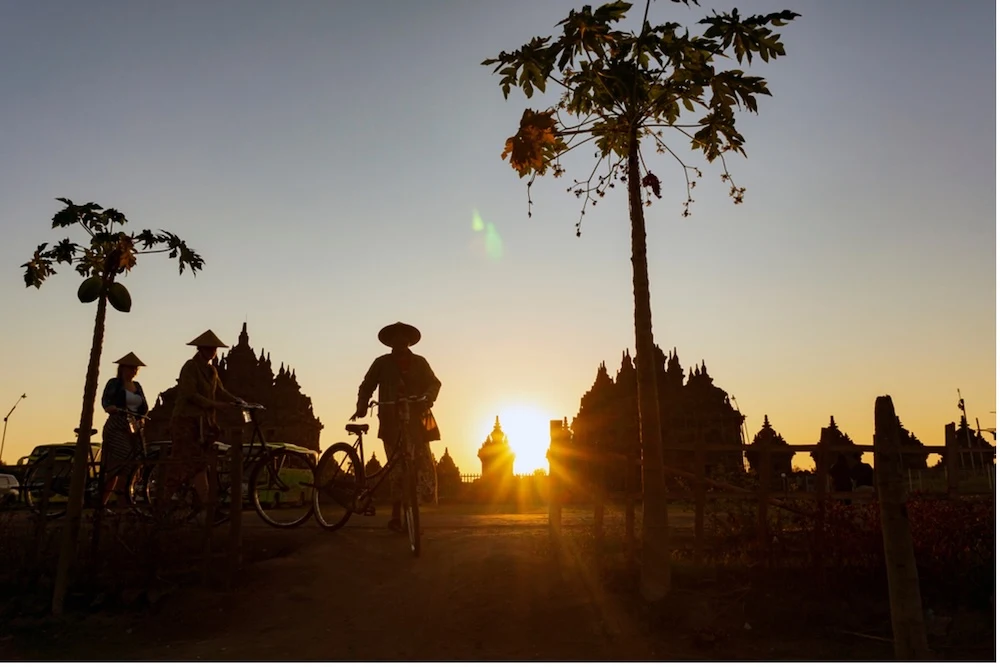
Kampot and Kep: Pepper Plantations and Seaside Downtime
Head south to Kampot and Kep at the end of the trip, when you’re ready to slow your pace and relax a little.
The region is home to Kampot peppercorn plantations. This mildly spicy peppercorn that’s unique to Cambodia nearly became extinct during the Khmer Rouge regime, but has made a surprising comeback.
Cycling is a great way to explore the plantations. You can bike ride through the planting fields where the air is pungent with the smell of red, black and white peppercorns. The scenery is impressive and your photos will be amazing.
When you’re really done with cycling and ready for some R&R, head to nearby Kep, which sits on the Gulf of Thailand, and hop a boat to Rabbit Island.
Once you’re there find a shady spot and lay out on the white sand. If you have the energy, swim, or try snorkeling in the clear water. It’s a complete getaway from the hustle and bustle you’ve encountered everywhere else.
There are small hotels where you can stay overnight if your kids (or you) want more than just an afternoon at the beach.
Either way, after your beach day, take a tuk tuk or taxi to Kep’s crab market. If you time it right, you can watch the fishing boats come in with the day’s catch.
Explore the market and do a little scouting. When you’re ready, buy crabs or whatever other seafood tempts you – shrimp, squid, all kinds of fish –fresh from the water. And ask the vendor to point you to a nearby restaurant where they will cook it up to order. And ideally serve it with a sunset view.
Locals love to douse the crabs with those kampot peppercorns, giving them a completely local twist.
You can see the Kampot plantations, the bamboo train and the crab market all in one day via an organized tour. But it’s a packed day and probably not relaxing.
If you have the time, slow down to see each area on its own, especially with kids. You’ll have time to hop on a bicycle one more time. And relax on a sandy beach as well. What better way to end your family’s Cambodia adventure?
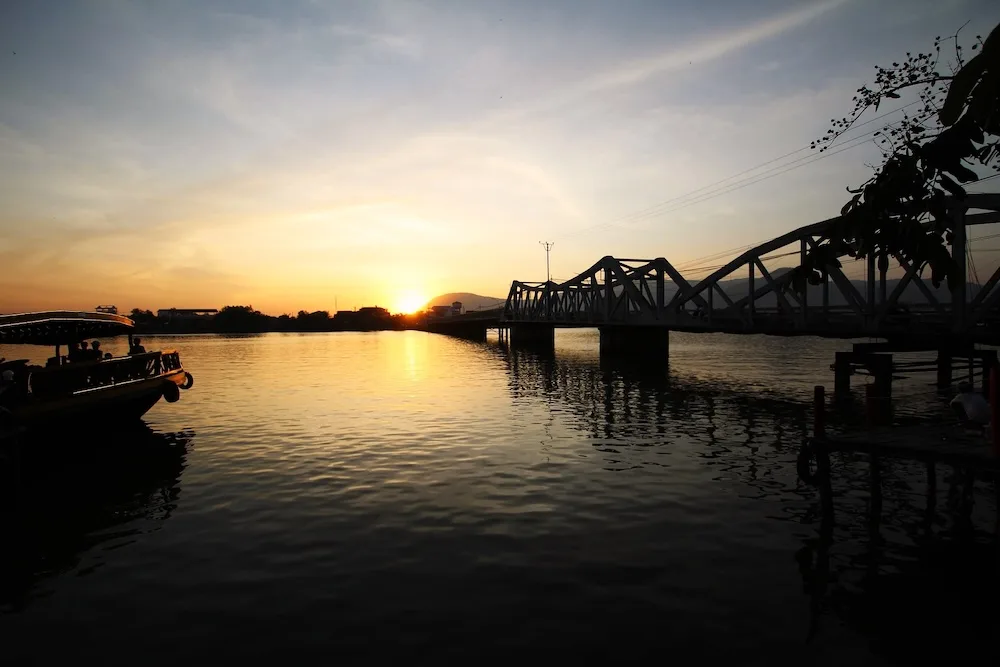
Some Practical Tips for Cyclists
Here are a few practical tips for your Cambodian bicycling adventures:
Know the parts of your bike
Learn basic bike maintenance. Your tour guides should know how to adjust seats and breaks and fix a flat. But knowing these things for yourself can’t hurt.
And this way you’ll be more confident heading out on your own if the mood and opportunity strike.
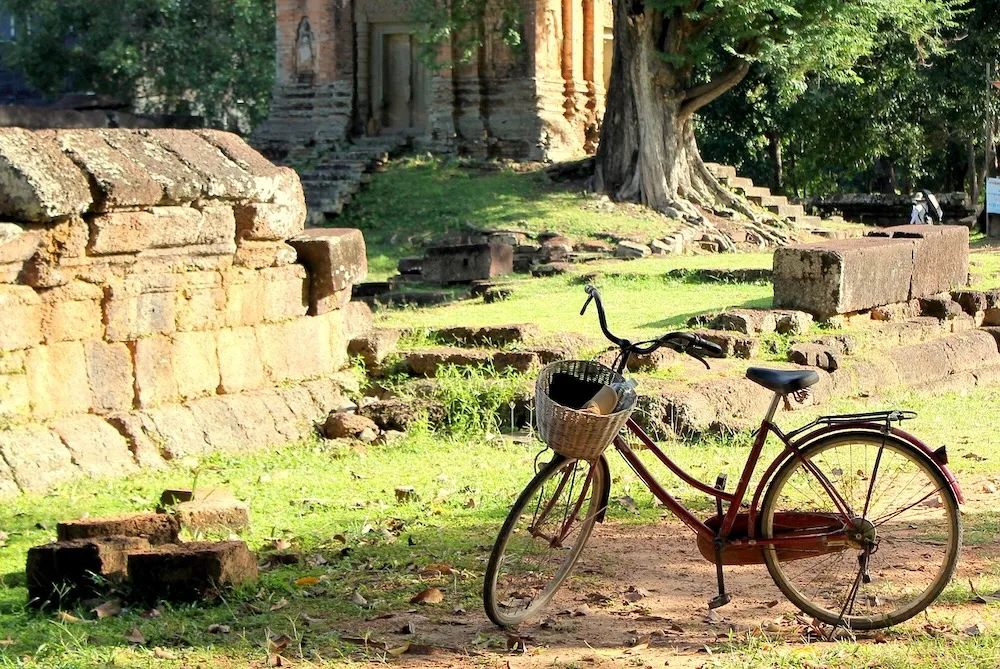
What kind of bikes:
• Teens can handle the riding, maybe better than you can. But give them a quick lesson on road rules, road safety and defensive riding if they aren’t used to cycling on roads.
• For kids under 5 plan to use a bicycle seat or trailer. Ask in advance about these extras.
• Until kids are tall enough to ride a full-sized bike, I would try to rent tandems or leave a lot of flexibility as to how far to cycle in a day.
The smaller wheels on kids’ bikes mean they have to pedal twice as much as you do to go the same distance. And kids poop out way before adults do in the heat. Tandems allow them to stop pedaling when they need a break, which will help everyone enjoy the ride more.
Again, inquire about these options before you book.
Things to Pack:
Headlamps and clip-on lights. For early morning starts and late returns.
A headlamp will help you avoid obstacles like potholes and tree roots. Safety lights that hook onto the back of your clothes will allow traffic to see you in the dark.
Helmets. Find out in advance if the tour companies you’re working with provides adult and child helmets. If not, you’ll rest easier if you pack your own.
• Padded bike shorts. Your backside will thank you after your longer rides.
Tip: Buy shorts that are on the longer side. They’ll protect your thighs from sunburn. And in Cambodia’s conservative culture they’ll attract less attention than skimpy shorts will.
Water Bottles. The Cambodian sun is no joke. Drink more water than you think you need. You’ll be drinking bottled water but being able to pour a few bottles into one larger water bottle per person will be easier than carrying lots of throw-away bottles.
Sun Glasses. Not just for the sun. They will be your windshields and protect your eyes from dust, wind and debris.
Should you worry about landmines?
Probably not. And maybe.
Cambodia’s bucolic countryside is the hiding place for too many unexploded landmines, an unhappy souvenir of the Khmer Rouge’s regime and regional skirmishes.
Several international organizations have been doggedly working for a few decades to map minefields and remove the explosives, but it will take some time yet.
The countryside around popular tourist destinations has been cleared. And the biggest clusters are near the border with Thailand, far from the places mentioned in this article.
But not all minefields have been mapped. If you want to pedal into the countryside and get off the beaten track, going with a local guide is your safest bet.
If you go cycling on your own in the back country, stick to well-trodden paths. Look for and respect any posted signs about landmines and listen to the locals when they tell you of any places to avoid.
With that warning out of the way, hope you’ll reach for bicycles and explore Cambodia on two wheels when you visit. Your reward will be unfiltered access to scenic rice paddies, local village life, the smells of family dinners cooking and lots of curious children.
Plus, there is the chance to take in popular tourist sights from different vantage points than the ones absolutely everyone else is using. That, in itself, is worth the effort.
Pin it for later!
